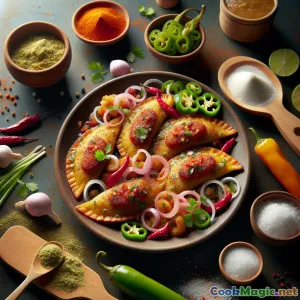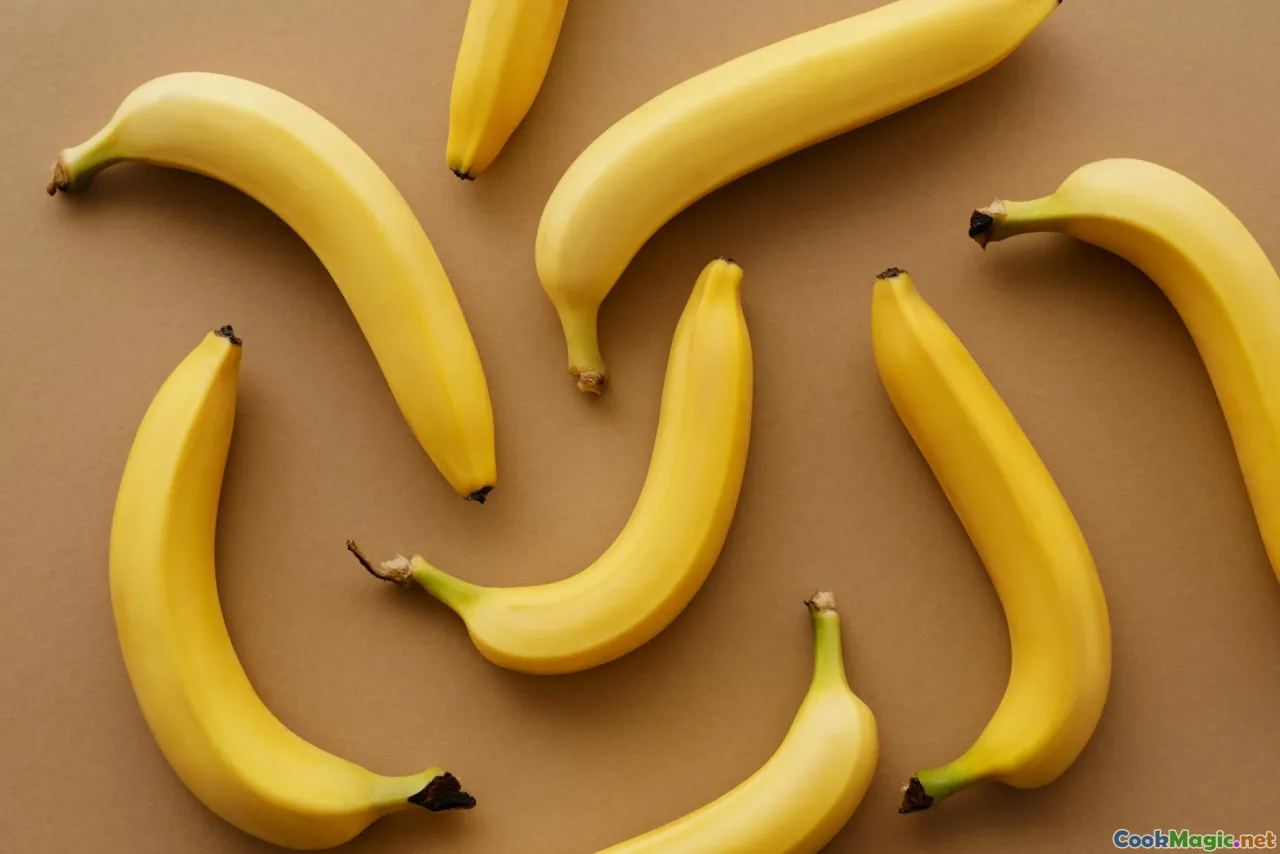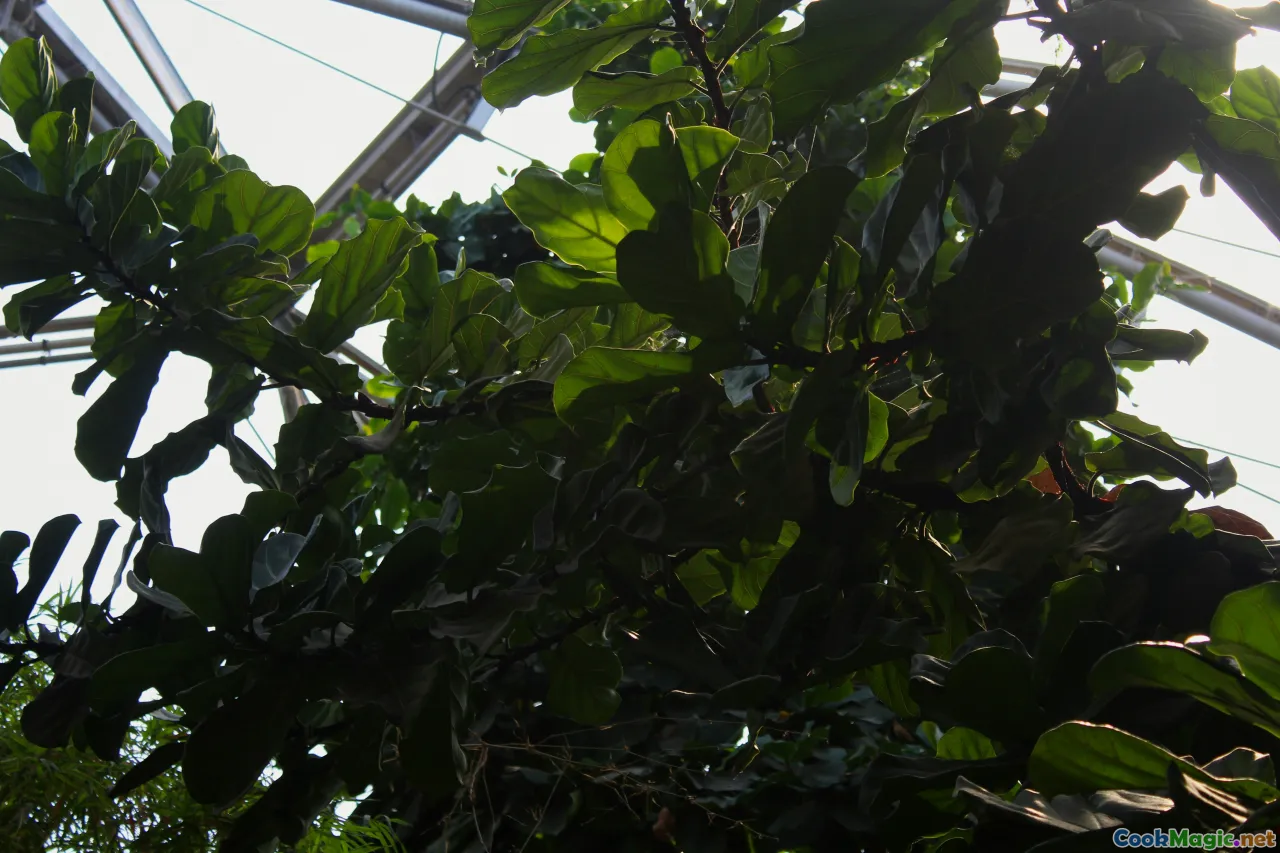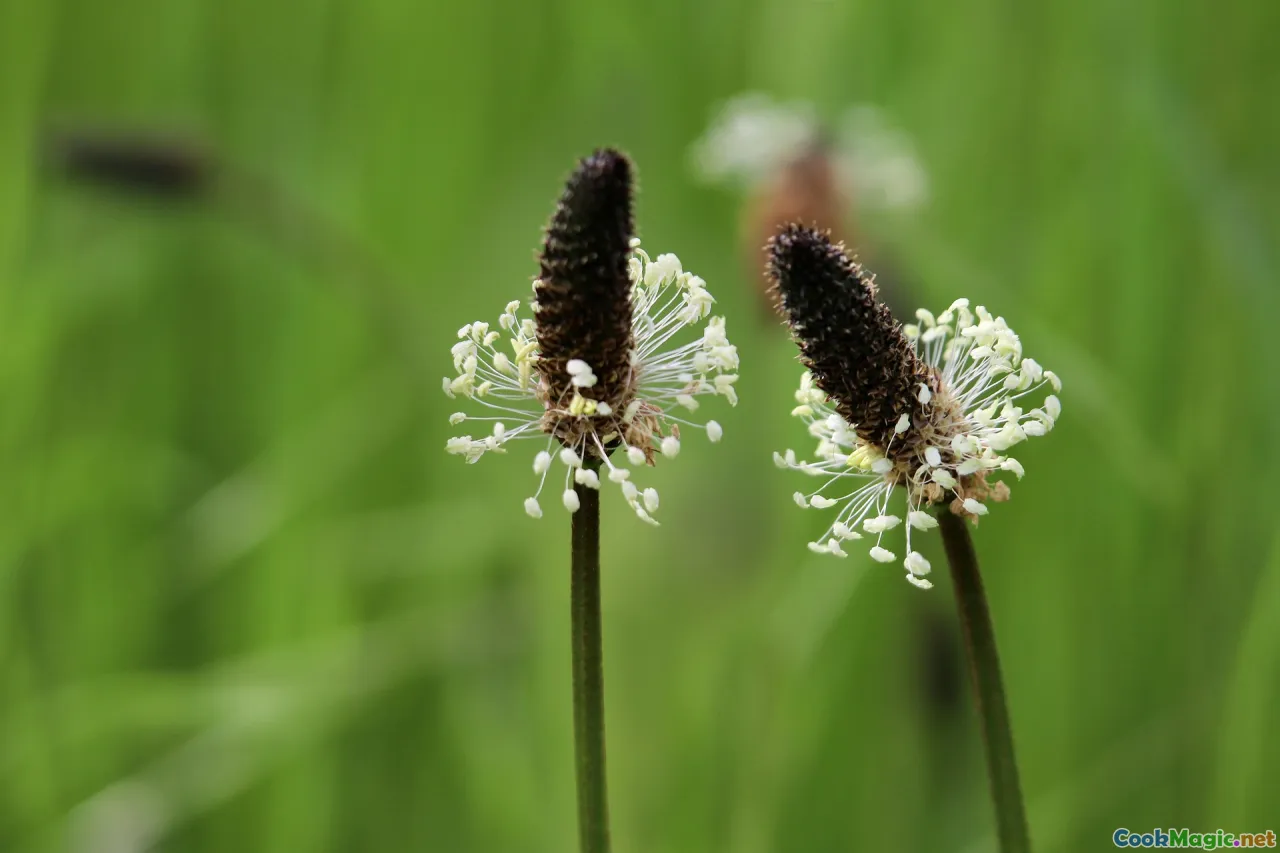
Empanadas Pisang Plantain Macho ala Guna dengan Ikan Santan Kelapa
(Guna-Style Plantain Empanadas with Coconut Fish)
(0 Ulasan)0
305
Oktober 13, 2025
Laporkan Masalah
Bahan
-
1200 grams Pisang raja hijau (tegar, mentah)
(About 6 large; greener is better for dough structure)
-
10 grams garam laut halus
(About 2 tsp; divide for dough and seasoning)
-
2 tbsp Minyak Achiote (annatto)
(Adds color and earthiness; use paprika oil if needed)
-
60 grams tepung tapioca atau singkong
(Helps bind the plantain dough; cornstarch works in a pinch)
-
60 ml Susu kelapa penuh lemak
(Just enough to soften the dough; do not over-wet)
-
0.5 tsp Baking powder
(A touch for lighter crust)
-
300 grams Ikan asap atau asin (makarel, bacalao), serpihan
(Desalt if using bacalao; canned smoked fish works)
-
100 grams Bawang bombay kuning, cincang halus
(About 1 small onion)
-
30 grams Daun bawang iris tipis
(About 2 scallions; white and green parts)
-
3 cloves Bawang putih (cincang)
(Freshly minced for best aroma)
-
80 grams Paprika merah, dipotong dadu kecil
(Menambah manis dan warna)
-
1 piece Ají chombo atau habanero, dicincang halus
(Remove seeds for less heat; use to taste)
-
10 grams Daun culantro segar (recao) atau ketumbar, dicincang
(Culantro preferred; cilantro is acceptable)
-
120 ml Susu kelapa untuk isian
(Creates a luscious, aromatic filling)
-
30 ml Jus Jeruk Nipis Segar
(Brightens the filling; keep extra for serving)
-
1 tsp Jinten bubuk
(Warm spice note, optional)
-
0.5 tsp Lada hitam baru giling
(Bumbu sesuai selera)
-
1 tbsp Minyak netral atau minyak kelapa (untuk menumis)
(Just enough to sweat aromatics)
-
700 ml Minyak kelapa atau minyak netral (untuk menggoreng)
(Enough for shallow or deep frying)
-
6 pieces Irisan jeruk nipis tambahan
(Untuk disajikan)
-
2 tsp saus pedas ají chombo Panama
(Optional drizzle when serving)
(About 6 large; greener is better for dough structure)
(About 2 tsp; divide for dough and seasoning)
(Adds color and earthiness; use paprika oil if needed)
(Helps bind the plantain dough; cornstarch works in a pinch)
(Just enough to soften the dough; do not over-wet)
(A touch for lighter crust)
(Desalt if using bacalao; canned smoked fish works)
(About 1 small onion)
(About 2 scallions; white and green parts)
(Freshly minced for best aroma)
(Menambah manis dan warna)
(Remove seeds for less heat; use to taste)
(Culantro preferred; cilantro is acceptable)
(Creates a luscious, aromatic filling)
(Brightens the filling; keep extra for serving)
(Warm spice note, optional)
(Bumbu sesuai selera)
(Just enough to sweat aromatics)
(Enough for shallow or deep frying)
(Untuk disajikan)
(Optional drizzle when serving)
Nutrisi
- Porsi: 6
- Ukuran Porsi: 2 empanadas (180g)
- Calories: 590 kcal
- Carbohydrates: 70 g
- Protein: 19 g
- Fat: 24 g
- Fiber: 8 g
- Sugar: 15 g
- Sodium: 820 mg
- Cholesterol: 45 mg
- Calcium: 90 mg
- Iron: 2.8 mg
Instruksi
-
1 - Prep the plantains:
Trim ends and make a shallow lengthwise slit through the peel of each green plantain. This helps peeling after cooking and prevents splitting.
-
2 - Parboil and peel:
Simmer plantains in salted water until knife-tender (12–15 minutes). Drain, cool slightly, then peel while warm by lifting off the loosened skins.
-
3 - Mash and season the dough:
Mash warm plantains until smooth. Mix in 1 tsp salt, achiote oil, tapioca starch, coconut milk, and baking powder if using. The dough should be soft but not sticky.
-
4 - Rest the Dough:
Cover and let the dough rest to hydrate starches and firm slightly. If sticky, knead in 1–2 tbsp more starch.
-
5 - Build the filling base:
Heat 1 tbsp oil in a skillet. Sauté onion, scallions, red pepper, and garlic with a pinch of salt until translucent and fragrant.
-
6 - Finish the fish filling:
Add flaked fish, ají chombo, cumin, and black pepper. Stir in 120 ml coconut milk; simmer 2–3 minutes until cohesive. Off heat, add lime juice and culantro. Cool completely.
-
7 - Portion and press discs:
Divide dough into 12 equal balls. Press each between plastic sheets with a tortilla press or skillet to 12–13 cm discs, about 3 mm thick.
-
8 - Fill and seal:
Place 1–1.5 tbsp filling on each disc. Fold into half-moon, expel air, and crimp edges firmly with a fork or pleat by hand to prevent leaks.
-
9 - Chill for clean frying:
Arrange empanadas on a tray and chill 10 minutes. This helps the plantain crust set and reduces breakage in hot oil.
-
10 - Fry to golden perfection:
Heat frying oil to 175°C. Fry empanadas in batches 3–4 minutes per side until deep golden. Drain on a rack; sprinkle with a pinch of salt.
-
11 - Serve Guna-style:
Serve hot with lime wedges and a cautious drizzle of ají chombo. Enjoy immediately while crisp.
Trim ends and make a shallow lengthwise slit through the peel of each green plantain. This helps peeling after cooking and prevents splitting.
Simmer plantains in salted water until knife-tender (12–15 minutes). Drain, cool slightly, then peel while warm by lifting off the loosened skins.
Mash warm plantains until smooth. Mix in 1 tsp salt, achiote oil, tapioca starch, coconut milk, and baking powder if using. The dough should be soft but not sticky.
Cover and let the dough rest to hydrate starches and firm slightly. If sticky, knead in 1–2 tbsp more starch.
Heat 1 tbsp oil in a skillet. Sauté onion, scallions, red pepper, and garlic with a pinch of salt until translucent and fragrant.
Add flaked fish, ají chombo, cumin, and black pepper. Stir in 120 ml coconut milk; simmer 2–3 minutes until cohesive. Off heat, add lime juice and culantro. Cool completely.
Divide dough into 12 equal balls. Press each between plastic sheets with a tortilla press or skillet to 12–13 cm discs, about 3 mm thick.
Place 1–1.5 tbsp filling on each disc. Fold into half-moon, expel air, and crimp edges firmly with a fork or pleat by hand to prevent leaks.
Arrange empanadas on a tray and chill 10 minutes. This helps the plantain crust set and reduces breakage in hot oil.
Heat frying oil to 175°C. Fry empanadas in batches 3–4 minutes per side until deep golden. Drain on a rack; sprinkle with a pinch of salt.
Serve hot with lime wedges and a cautious drizzle of ají chombo. Enjoy immediately while crisp.
Informasi Lebih Lanjut: Empanadas Pisang Plantain Macho ala Guna dengan Ikan Santan Kelapa
Empanadas de Plátano Macho al Estilo Guna
These empanadas pay homage to the coastal ingenuity of the Guna (also spelled Kuna) people of Panama, whose cooking is informed by the sea, coconut palms, and river valleys where plantains thrive. Instead of wheat flour, the crust is a supple masa made from green plantains. The result is a vibrant golden shell—thanks to achiote—that fries up shatter-crisp outside and soft within, encasing a coconut-simmered fish filling laced with culantro and a whisper of ají chombo heat.
Why this recipe works
- Plantains as dough: Unripe (green) plantains are starchy and low in moisture. When mashed warm and combined with a touch of starch, they form a naturally gluten-free dough sturdy enough to shape and fry without cracking.
- Achiote oil: Annatto infuses earthy notes and a deep amber hue that visually cues the empanadas’ savoriness while echoing coastal Panamanian color and flavor traditions.
- Coconut-simmered filling: Coconut milk softens the smokiness of fish, adding silkiness and subtle sweetness that balance ají chombo’s fire and the plantain’s gentle fruitiness.
Ingredient insights
- Green plantains: Choose heavy, bright green fruit without yellowing. Any ripening (yellow spots) will sweeten and soften the dough, making it prone to tearing. If that’s all you can find, increase starch a little.
- Fish: Smoked mackerel brings depth and convenience. Salted bacalao is traditional in parts of the region—soak and simmer to remove excess salt before flaking. Canned smoked fish works in a pinch; taste for salt.
- Culantro vs. cilantro: Culantro (Eryngium foetidum) is common in Panama and the Caribbean, with a bolder, deeper profile than cilantro. If unavailable, cilantro provides a bright, familiar stand-in.
- Ají chombo: A Panamanian cousin of Scotch bonnet/habanero that gives fruity heat. Use sparingly and always mince carefully; balance with lime.
Technique notes
- Dough texture: The dough should be soft, warm, and pliable, not sticky. Resting allows starches to hydrate and plantain fibers to relax, making pressing and sealing cleaner.
- Pressing discs: Lining a press or plate with plastic (a cut freezer bag works) ensures easy release. Aim for even thickness to avoid weak points that can burst during frying.
- Cooling the filling: Hot, loose filling will steam the dough and break seals. Cool completely for tidy assembly.
- Fry temperature: 170–175°C is the sweet spot. Too cool yields greasy crusts; too hot browns before the dough heats through. Work in small batches to keep the temperature stable.
Tips, swaps, and variations
- Protein swap: Replace fish with shredded rotisserie chicken, sautéed mushrooms, or grated green papaya for a vegetarian version. Keep the coconut, lime, and herbs for signature flavor.
- Oil choice: Coconut oil is aromatic and authentic; neutral oils like peanut or canola yield equally crisp results.
- Make it spicier: Fold a few drops of ají chombo into the filling or serve on the side. For mild palates, remove chili seeds and membranes.
- Better sealing: Lightly moisten edges with water or coconut milk before crimping. Double-crimp for extra security.
- Bake instead of fry: Brush with oil and bake at 220°C for 18–22 minutes, flipping once. Texture differs—crisp edges, slightly drier crumb—but still delicious.
Make-ahead and storage
- Fillings: Prepare up to 2 days ahead; store chilled. It should be thick and cohesive.
- Shaped empanadas: Freeze in a single layer, then bag. Fry from frozen at 170°C, adding 1–2 minutes to cook time.
- Reheating: Recrisp in a 200°C oven or air fryer for 6–8 minutes.
Cultural note
Guna Yala (formerly San Blas) is an autonomous region along Panama’s Caribbean coast, a necklace of islands where canoes crowd turquoise shallows and coconut palms draw silhouettes at sunset. The Guna diet reflects this seascape—fish, coconut, plantains, and cassava—prepared simply yet vividly. While wheat-based empanadas are common across Latin America, plantain empanadas echo a deeper indigenous logic: use what is abundant. The achiote-kissed crust and coconut-laced filling resonate with broader Caribbean tastes while remaining distinctly Panamanian.
Serving ideas
- Fresh squeeze of lime and chopped culantro to finish.
- A bright slaw of cabbage, carrots, and pineapple for crunch and acidity.
- A quick “coco-lima” dip: 3 tbsp coconut milk, 1 tbsp lime juice, a pinch of salt, and 2–3 drops of ají chombo.
Troubleshooting
- Dough cracks while shaping: The dough is too dry or cool. Knead in a teaspoon of coconut milk and re-warm briefly, or rest longer.
- Empanadas burst in oil: Filling was too wet or steam built up. Reduce coconut milk next time; be sure edges are well-sealed and air is pressed out.
- Greasy crust: Oil temperature was low. Reheat oil and fry in small batches.
Sustainability and sourcing
Choose fish from responsible sources; smoked mackerel and line-caught coastal species are solid picks. If using salted cod, look for brands that certify sustainable fisheries. Coconut milk with minimal additives yields cleaner flavor and better texture.
These Guna-style plantain empanadas are a celebration of resourcefulness and place: green plantains transformed into a golden shell, sea-scented filling enriched by coconut, and a spark of ají chombo to nod at the Caribbean’s bold spirit. Crispy, fragrant, and satisfying, they’re perfect as a street-food snack, a festive appetizer, or the main event with a simple salad and cold cerveza. One bite will transport you to sunlit shores and paddle-silent lagoons—an edible postcard from Panama.


















